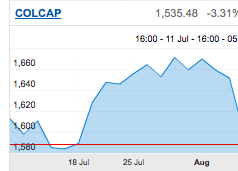BOGOTA, Colombia—Some 2,500 miles from the panic that is hitting the New York Stock Exchange today, there is an odd sense of optimism pervading economic circles. Welcome to Latin America, home to what may well be the world’s most buoyant—and in many ways most promising—Great Recession recovery. Across the region, economies are growing at an impressive clip, foreign direct investment is rising, interest rates and inflation are stable, and business is booming. As a region, Latin America is expected to post GDP growth rates this year of between 4 and 5 percent in 2011. (By comparison, the United States is hovering around 1 percent growth.) This map of GDP growth rates offers a nice visualization of just how impressive the region’s growth is.
But here’s some even better news on an otherwise dismal financial day: If investors do start to turn away from U.S. stocks and bonds, they might come here—and help fuel the Latin American decade that stands to lift millions from poverty. The World Bank already estimates that all of those who were pushed into poverty during the 2008 crash will surmount it thanks to current growth rates. If growth, investment, and the boom continue apace, those numbers will almost certainly rise.
How did Latin America surmount the global economic doom? Some economists have half-joked that Latin America learned its fiscal and monetary lessons from financial crises past. To some extent its true; inflation today is remarkably stable in most countries (there are some concerns in Argentina and Venezuela.) Relatively balanced budgets are the norm, not the exception.
But perhaps even more importantly, Latin America has taken the shifts in the global economy and adapted to them—rather than lamenting or resisting them. Exports are shifting to China? Let’s build ports, airports, and an export infrastructure to accommodate. It also happens that many of the products that Latin America is selling, Asia is buying. Mineral exports and agriculture are front and center. Peru and Chile now lead the regional shift, exporting more in 2010 to Asia Pacific region than they did to either the European Union or the United States. Peru, Colombia, and Chile—all star economic performers—are also talking of merging their stock markets, a move that would make it far easier for international funds to flow in.
So back to the current crisis on hand: If investors start to turn away from the United States, they will almost certainly look south. Here in Colombia, this is already happening: foreign direct investment is expected to rise to $10 billion this year—already, the first quarter saw a 57 percent increase from the same period in 2010. This is fantastic news in a country that remains one of the world’s most unequal. Manufacturing, agriculture, and outsourced remote service centers—all labor intensive (read: job creating) industries—are increasingly cropping up here. While economic growth alone is no guarantee that poverty rates will drop also, development is yet another area that this region is starting to do very well. The famous cash-transfer programs that get kids in school and get the poor resources started in Mexico, for example.
In short, if I were on Wall St. today, you know where I’d be looking for a safe haven.
